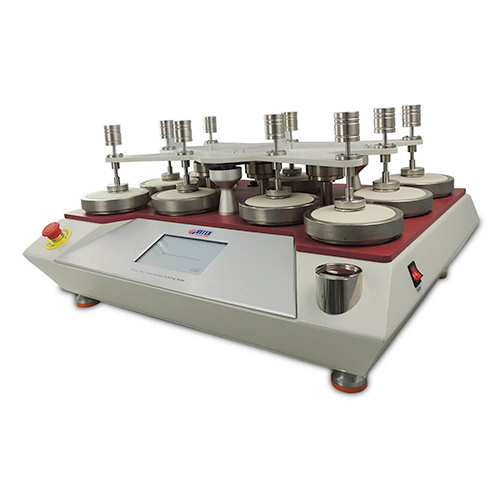Application
Martindale Abrasion & Pilling Tester. To determine the abrasion and pilling resistance of all
kinds of textile structures. Samples are rubbed against known abrasives at low pressures and
in continuously changing directions. The amount of abrasion or pilling is compared against
standard parameters.
The unique design of our Martindale abrasion tester allows removal of individual sample
holders for examination without lifting the top motion plate. It provides individual counters and
parking function, interval time settable and a large touch-screen display. Standard sample
holders and 9 and 12kpa Weights are included.
The Martindale abrasion tester is available with 4, 6, 8 or 9 test positions.
Included Accessories (1 for each station)
Abrasion test (To ISO 12947-1)
a) Mounting weight (2.5+/-0.5kg, for both abrasion and pilling test)
b) Abrasion tester holders (Dia. 38 mm)
c) Loading Weights (395+/-7g)
d) Loading Weights (595+/-7g)
Pilling Test (To ISO 12945-2)
a) Linear adaptor. To convert to straight-line motion.
b) Sample Retaining Rings for pilling test
c) Pilling test holders (Dia. 90mm)
d) Loading Weights (260+/-1g)
1 Auxiliary device for specimen .
1 Drawing pen
1 set of abradent fabric, wool felt, backing foam for each work station.
Optional orders
a) Specimen Cutter. (Dia. 38mm) with cutting mat and spare blades.
b) Abrasive Fabric & Backing Felt Cutter. (Dia. 140mm) with cutting mat and spare blades.
c) Standard Wool Abrasive Fabric SM25. 1.6M wide x 5M length – For abrasion test and pilling test(when automatic)
d) Standard Backing Foam. Width 1.5M, Length 0.5M.
e) Standard Backing Wool Felt Piece (woven) 1m x 1.5m.
f) EMPA Photographic Standards for Pilling Test (3 x 4 knitted)
g) EMPA Photographic Standards for Pilling Test (3 x 4 woven)
h) SM 50 Photographs for Pilling Test IWS + ASTM.
Standards
EN ISO 12945-2/12947-1/12947-2/12947-3/12947-4, ISO 20344, ASTM 4966/4970, BS EN
388/530, BS 3424/5690, JIS L1096, DIN 53863/53865, GB/T 13775, SATRA TM31, IS 12673, IWSTM 112/196, IWTO 40-88, SFS 4328, NEXT 16, GMW15651, ISO 5470-2, M&S 17 / 19 /
19C, Next 18/18a/18b, GB/T 4802.2/21196 1/21196-2, Wool Mark TM 112/196
Power
220 /110 V 50/60 Hz
Weight
155 Kg
Dimensions
920 x 760 x 630 mm (L x W x H)



